中英文对照论文
- 格式:doc
- 大小:48.50 KB
- 文档页数:7
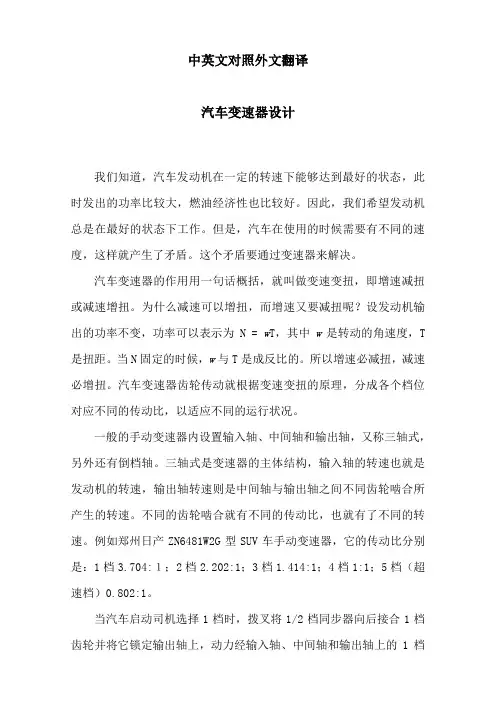
中英文对照外文翻译汽车变速器设计我们知道,汽车发动机在一定的转速下能够达到最好的状态,此时发出的功率比较大,燃油经济性也比较好。
因此,我们希望发动机总是在最好的状态下工作。
但是,汽车在使用的时候需要有不同的速度,这样就产生了矛盾。
这个矛盾要通过变速器来解决。
汽车变速器的作用用一句话概括,就叫做变速变扭,即增速减扭或减速增扭。
为什么减速可以增扭,而增速又要减扭呢?设发动机输出的功率不变,功率可以表示为 N = w T,其中w是转动的角速度,T 是扭距。
当N固定的时候,w与T是成反比的。
所以增速必减扭,减速必增扭。
汽车变速器齿轮传动就根据变速变扭的原理,分成各个档位对应不同的传动比,以适应不同的运行状况。
一般的手动变速器内设置输入轴、中间轴和输出轴,又称三轴式,另外还有倒档轴。
三轴式是变速器的主体结构,输入轴的转速也就是发动机的转速,输出轴转速则是中间轴与输出轴之间不同齿轮啮合所产生的转速。
不同的齿轮啮合就有不同的传动比,也就有了不同的转速。
例如郑州日产ZN6481W2G型SUV车手动变速器,它的传动比分别是:1档3.704:1;2档2.202:1;3档1.414:1;4档1:1;5档(超速档)0.802:1。
当汽车启动司机选择1档时,拨叉将1/2档同步器向后接合1档齿轮并将它锁定输出轴上,动力经输入轴、中间轴和输出轴上的1档齿轮,1档齿轮带动输出轴,输出轴将动力传递到传动轴上(红色箭头)。
典型1档变速齿轮传动比是3:1,也就是说输入轴转3圈,输出轴转1圈。
当汽车增速司机选择2档时,拨叉将1/2档同步器与1档分离后接合2档齿轮并锁定输出轴上,动力传递路线相似,所不同的是输出轴上的1档齿轮换成2档齿轮带动输出轴。
典型2档变速齿轮传动比是2.2:1,输入轴转2.2圈,输出轴转1圈,比1档转速增加,扭矩降低。
当汽车加油增速司机选择3档时,拨叉使1/2档同步器回到空档位置,又使3/4档同步器移动直至将3档齿轮锁定在输出轴上,使动力可以从轴入轴—中间轴—输出轴上的3档变速齿轮,通过3档变速齿轮带动输出轴。
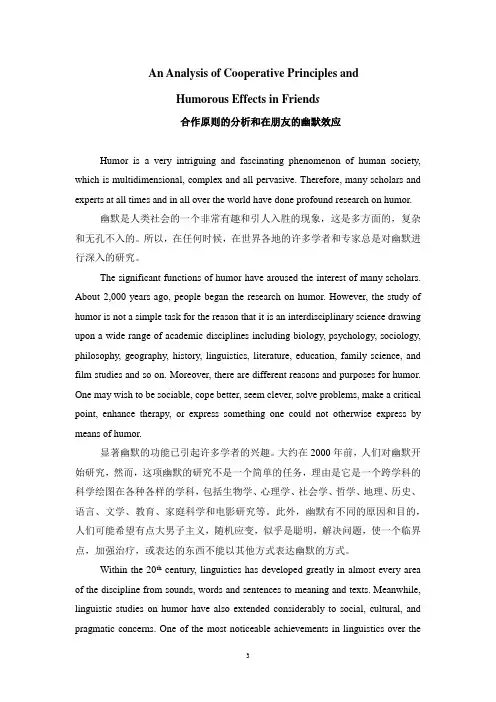
An Analysis of Cooperative Principles andHumorous Effects in Friend s合作原则的分析和在朋友的幽默效应Humor is a very intriguing and fascinating phenomenon of human society, which is multidimensional, complex and all pervasive. Therefore, many scholars and experts at all times and in all over the world have done profound research on humor.幽默是人类社会的一个非常有趣和引人入胜的现象,这是多方面的,复杂和无孔不入的。
所以,在任何时候,在世界各地的许多学者和专家总是对幽默进行深入的研究。
The significant functions of humor have aroused the interest of many scholars. About 2,000 years ago, people began the research on humor. However, the study of humor is not a simple task for the reason that it is an interdisciplinary science drawing upon a wide range of academic disciplines including biology, psychology, sociology, philosophy, geography, history, linguistics, literature, education, family science, and film studies and so on. Moreover, there are different reasons and purposes for humor. One may wish to be sociable, cope better, seem clever, solve problems, make a critical point, enhance therapy, or express something one could not otherwise express by means of humor.显著幽默的功能已引起许多学者的兴趣。

译文交通拥堵和城市交通系统的可持续发展摘要:城市化和机动化的快速增长,通常有助于城市交通系统的发展,是经济性,环境性和社会可持续性的体现,但其结果是交通量无情增加,导致交通拥挤。
道路拥挤定价已经提出了很多次,作为一个经济措施缓解城市交通拥挤,但还没有见过在实践中广泛使用,因为道路收费的一些潜在的影响仍然不明。
本文首先回顾可持续运输系统的概念,它应该满足集体经济发展,环境保护和社会正义的目标.然后,根据可持续交通系统的特点,使拥挤收费能够促进经济增长,环境保护和社会正义。
研究结果表明,交通拥堵收费是一个切实有效的方式,可以促进城市交通系统的可持续发展。
一、介绍城市交通是一个在世界各地的大城市迫切关注的话题。
随着中国的城市化和机动化的快速发展,交通拥堵已成为一个越来越严重的问题,造成较大的时间延迟,增加能源消耗和空气污染,减少了道路网络的可靠性.在许多城市,交通挤塞情况被看作是经济发展的障碍.我们可以使用多种方法来解决交通挤塞,包括新的基础设施建设,改善基础设施的维护和操作,并利用现有的基础设施,通过需求管理策略,包括定价机制,更有效地减少运输密度.交通拥堵收费在很久以前就已提出,作为一种有效的措施,来缓解的交通挤塞情况。
交通拥堵收费的原则与目标是通过对选择在高峰拥挤时段的设施的使用实施附加收费,以纾缓拥堵情况.转移非高峰期一些出行路线,远离拥挤的设施或高占用车辆,或完全阻止一些出行,交通拥堵收费计划将在节省时间和降低经营成本的基础上,改善空气中的质量,减少能源消耗和改善过境生产力。
此计划在世界很多国家和地方都有成功的应用。
继在20世纪70年代初和80年代中期挪威与新加坡实行收费环,在2003年2月伦敦金融城推出了面积收费;直至现在,它都是已经开始实施拥挤收费的大都市圈中一个最知名的例子。
然而,交通拥堵收费由于理论和政治的原因未能在实践中广泛使用。
道路收费的一些潜在的影响尚不清楚,和城市发展的拥塞定价可持续性,需要进一步研究。
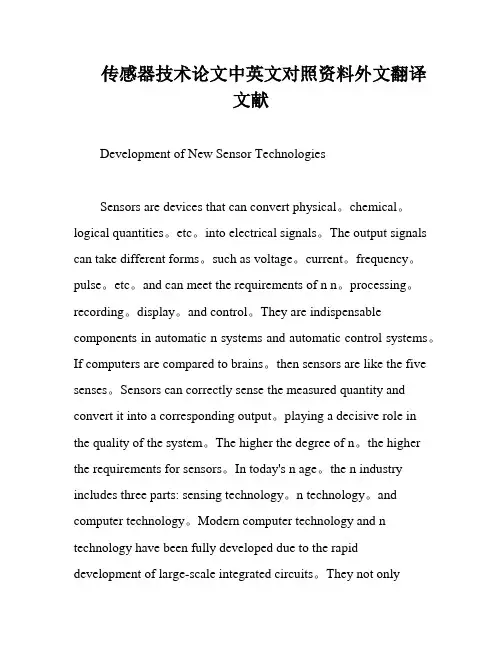
传感器技术论文中英文对照资料外文翻译文献Development of New Sensor TechnologiesSensors are devices that can convert physical。
chemical。
logical quantities。
etc。
into electrical signals。
The output signals can take different forms。
such as voltage。
current。
frequency。
pulse。
etc。
and can meet the requirements of n n。
processing。
recording。
display。
and control。
They are indispensable components in automatic n systems and automatic control systems。
If computers are compared to brains。
then sensors are like the five senses。
Sensors can correctly sense the measured quantity and convert it into a corresponding output。
playing a decisive role in the quality of the system。
The higher the degree of n。
the higher the requirements for sensors。
In today's n age。
the n industry includes three parts: sensing technology。
n technology。
and computer technology。
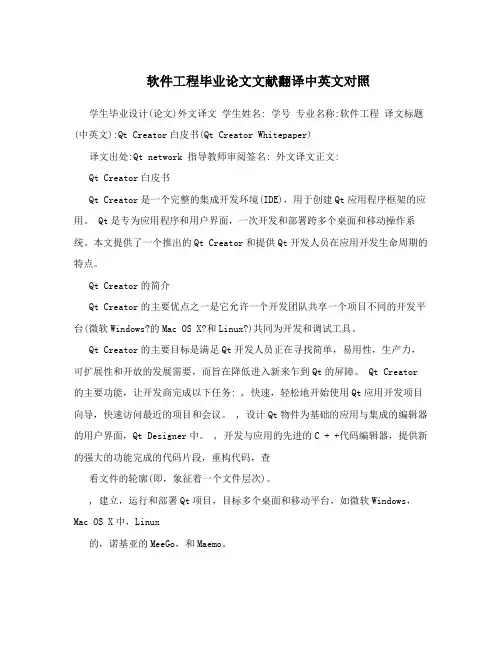
软件工程毕业论文文献翻译中英文对照学生毕业设计(论文)外文译文学生姓名: 学号专业名称:软件工程译文标题(中英文):Qt Creator白皮书(Qt Creator Whitepaper)译文出处:Qt network 指导教师审阅签名: 外文译文正文:Qt Creator白皮书Qt Creator是一个完整的集成开发环境(IDE),用于创建Qt应用程序框架的应用。
Qt是专为应用程序和用户界面,一次开发和部署跨多个桌面和移动操作系统。
本文提供了一个推出的Qt Creator和提供Qt开发人员在应用开发生命周期的特点。
Qt Creator的简介Qt Creator的主要优点之一是它允许一个开发团队共享一个项目不同的开发平台(微软Windows?的Mac OS X?和Linux?)共同为开发和调试工具。
Qt Creator的主要目标是满足Qt开发人员正在寻找简单,易用性,生产力,可扩展性和开放的发展需要,而旨在降低进入新来乍到Qt的屏障。
Qt Creator 的主要功能,让开发商完成以下任务: , 快速,轻松地开始使用Qt应用开发项目向导,快速访问最近的项目和会议。
, 设计Qt物件为基础的应用与集成的编辑器的用户界面,Qt Designer中。
, 开发与应用的先进的C + +代码编辑器,提供新的强大的功能完成的代码片段,重构代码,查看文件的轮廓(即,象征着一个文件层次)。
, 建立,运行和部署Qt项目,目标多个桌面和移动平台,如微软Windows,Mac OS X中,Linux的,诺基亚的MeeGo,和Maemo。
, GNU和CDB使用Qt类结构的认识,增加了图形用户界面的调试器的调试。
, 使用代码分析工具,以检查你的应用程序中的内存管理问题。
, 应用程序部署到移动设备的MeeGo,为Symbian和Maemo设备创建应用程序安装包,可以在Ovi商店和其他渠道发布的。
, 轻松地访问信息集成的上下文敏感的Qt帮助系统。
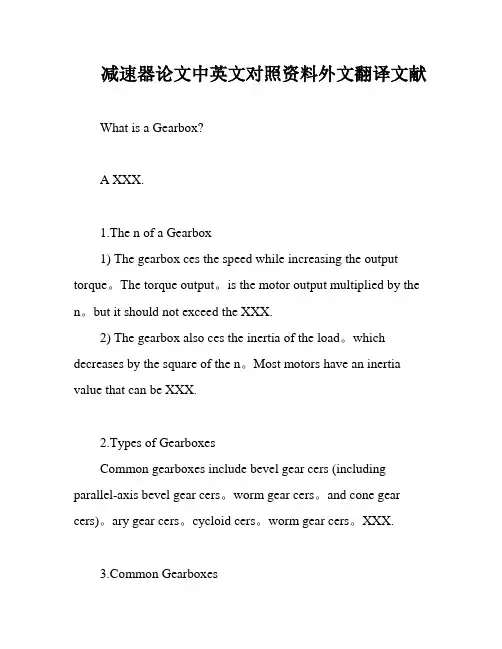
减速器论文中英文对照资料外文翻译文献What is a Gearbox?A XXX.1.The n of a Gearbox1) The gearbox ces the speed while increasing the output torque。
The torque output。
is the motor output multiplied by the n。
but it should not exceed the XXX.2) The gearbox also ces the inertia of the load。
which decreases by the square of the n。
Most motors have an inertia value that can be XXX.2.Types of GearboxesCommon gearboxes include bevel gear cers (including parallel-axis bevel gear cers。
worm gear cers。
and cone gear cers)。
ary gear cers。
cycloid cers。
worm gear cers。
XXX.mon Gearboxes1) The main feature of the worm gear cer is its reverse self-locking n。
which can achieve a large n。
The input and output shafts are not on the same axis or in the same plane。
However。
it generally has a large volume。
low n efficiency。
and low n.2) XXX and power。
It has a small size and high n。
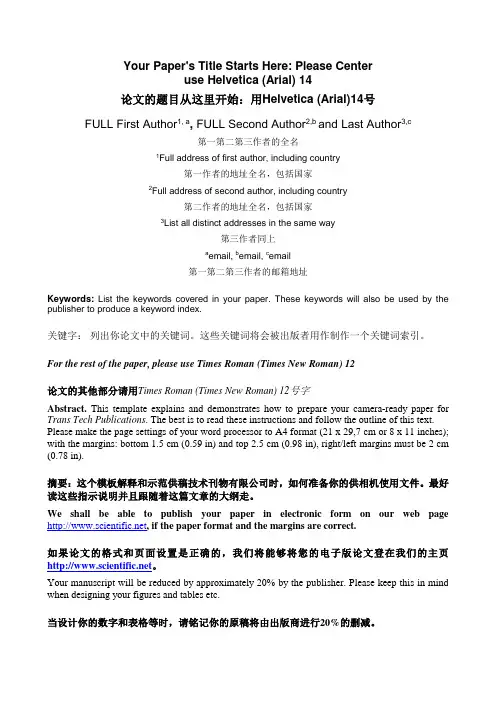
Your Paper's Title Starts Here: Please Centeruse Helvetica (Arial) 14论文的题目从这里开始:用Helvetica (Arial)14号FULL First Author1, a, FULL Second Author2,b and Last Author3,c第一第二第三作者的全名1Full address of first author, including country第一作者的地址全名,包括国家2Full address of second author, including country第二作者的地址全名,包括国家3List all distinct addresses in the same way第三作者同上a email,b email,c email第一第二第三作者的邮箱地址Keywords:List the keywords covered in your paper. These keywords will also be used by the publisher to produce a keyword index.关键字:列出你论文中的关键词。
这些关键词将会被出版者用作制作一个关键词索引。
For the rest of the paper, please use Times Roman (Times New Roman) 12论文的其他部分请用Times Roman (Times New Roman) 12号字Abstract. This template explains and demonstrates how to prepare your camera-ready paper for Trans Tech Publications. The best is to read these instructions and follow the outline of this text.Please make the page settings of your word processor to A4 format (21 x 29,7 cm or 8 x 11 inches); with the margins: bottom 1.5 cm (0.59 in) and top 2.5 cm (0.98 in), right/left margins must be 2 cm (0.78 in).摘要:这个模板解释和示范供稿技术刊物有限公司时,如何准备你的供相机使用文件。
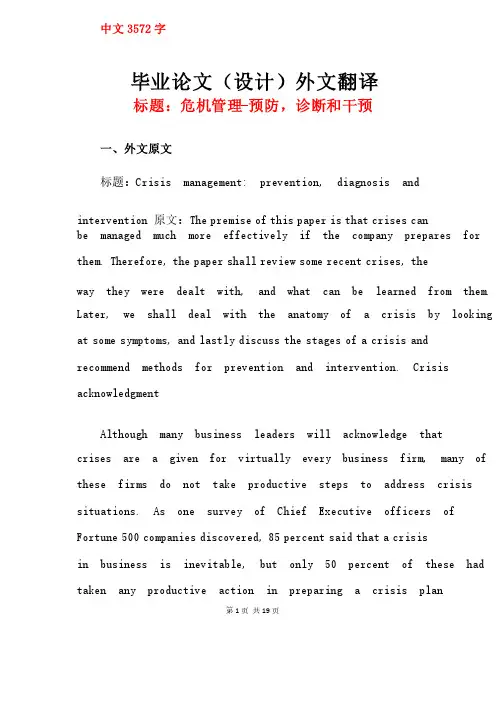
第1页 共19页中文3572字毕业论文(设计)外文翻译标题:危机管理-预防,诊断和干预一、外文原文标题:标题:Crisis management: prevention, diagnosis and Crisis management: prevention, diagnosis andintervention 原文:原文:The Thepremise of this paper is that crises can be managed much more effectively if the company prepares for them. Therefore, the paper shall review some recent crises, theway they were dealt with, and what can be learned from them. Later, we shall deal with the anatomy of a crisis by looking at some symptoms, and lastly discuss the stages of a crisis andrecommend methods for prevention and intervention. Crisis acknowledgmentAlthough many business leaders will acknowledge thatcrises are a given for virtually every business firm, many of these firms do not take productive steps to address crisis situations. As one survey of Chief Executive officers of Fortune 500 companies discovered, 85 percent said that a crisisin business is inevitable, but only 50 percent of these had taken any productive action in preparing a crisis plan(Augustine, 1995). Companies generally go to great lengths to plan their financial growth and success. But when it comes to crisis management, they often fail to think and prepare for those eventualities that may lead to a company’s total failure.Safety violations, plants in need of repairs, union contracts, management succession, and choosing a brand name, etc. can become crises for which many companies fail to be prepared untilit is too late.The tendency, in general, is to look at the company as a perpetual entity that requires plans for growth. Ignoring the probabilities of disaster is not going to eliminate or delay their occurrences. Strategic planning without inclusion ofcrisis management is like sustaining life without guaranteeinglife. One reason so many companies fail to take steps to proactively plan for crisis events, is that they fail to acknowledge the possibility of a disaster occurring. Like an ostrich with its head in the sand, they simply choose to ignorethe situation, with the hope that by not talking about it, it will not come to pass. Hal Walker, a management consultant, points out “that decisions will be more rational and better received, and the crisis will be of shorter duration, forcompanies who prepare a proactive crisis plan” (Maynard, 1993) .It is said that “there are two kinds of crises: those that thatyou manage, and those that manage you” (Augustine, 1995). Proactive planning helps managers to control and resolve a crisis. Ignoring the possibility of a crisis, on the other hand,could lead to the crisis taking a life of its own. In 1979, theThree-Mile Island nuclear power plant experienced a crisis whenwarning signals indicated nuclear reactors were at risk of a meltdown. The system was equipped with a hundred or more different alarms and they all went off. But for those who shouldhave taken the necessary steps to resolve the situation, therewere no planned instructions as to what should be done first. Hence, the crisis was not acknowledged in the beginning and itbecame a chronic event.In June 1997, Nike faced a crisis for which they had no existi existing frame of reference. A new design on the company’s ng frame of reference. A new design on the company’s Summer Hoop line of basketball shoes - with the word air writtenin flaming letters - had sparked a protest by Muslims, who complained the logo resembled the Arabic word for Allah, or God.The council of American-Islamic Relations threatened aa globalNike boycott. Nike apologized, recalled 38,000 pairs of shoes,and discontinued the line (Brindley, 1997). To create the brand,Nike had spent a considerable amount of time and money, but hadnever put together a general framework or policy to deal with such controversies. To their dismay, and financial loss, Nike officials had no choice but to react to the crisis. This incident has definitely signaled to the company that spending a little more time would have prevented the crisis. Nonetheless,it has taught the company a lesson in strategic crisis management planning.In a business organization, symptoms or signals can alert the strategic planners or executives of an eminent crisis. Slipping market share, losing strategic synergy anddiminishing productivity per man hour, as well as trends, issues and developments in the socio-economic, political and competitive environments, can signal crises, the effects of which can be very detrimental. After all, business failures and bankruptcies are not intended. They do not usually happen overnight. They occur more because of the lack of attention to symptoms than any other factor.Stages of a crisisMost crises do not occur suddenly. The signals can usuallybe picked up and the symptoms checked as they emerge. A company determined to address these issues realizes that the real challenge is not just to recognize crises, but to recognize themin a timely fashion (Darling et al., 1996). A crisis can consistof four different and distinct stages (Fink, 1986). The phasesare: prodromal crisis stage, acute crisis stage, chronic crisisstage and crisis resolution stage.Modern organizations are often called “organic” due tothe fact that they are not immune from the elements of their surrounding environments. Very much like a living organism, organizations can be affected by environmental factors both positively and negatively. But today’s successfulorganizations are characterized by the ability to adapt by recognizing important environmental factors, analyzing them, evaluating the impacts and reacting to them. The art of strategic planning (as it relates to crisis management)involves all of the above activities. The right strategy, in general, provides for preventive measures, and treatment or resolution efforts both proactively and reactively. It wouldbe quite appropriate to examine the first three stages of acrisis before taking up the treatment, resolution or intervention stage.Prodromal crisis stageIn the field of medicine, a prodrome is a symptom of the onset of a disease. It gives a warning signal. In business organizations, the warning lights are always blinking. No matter how successful the organization, a number of issues andtrends may concern the business if proper and timely attentionis paid to them. For example, in 1995, Baring Bank, a UK financial institution which had been in existence since 1763,ample opportunitysuddenly and unexpectedly failed. There wasfor the bank to catch the signals that something bad was on thehorizon, but the company’s efforts to detect that were thwarted by an internal structure that allowed a single employee both to conduct and to oversee his own investment trades, and the breakdown of management oversight and internalcontrol systems (Mitroff et al., 1996). Likewise, looking in retrospect, McDonald’s fast food chain was given the prodromalsymptoms before the elderly lady sued them for the spilling ofa very hot cup of coffee on her lap - an event that resulted in a substantial financial loss and tarnished image of thecompany. Numerous consumers had complained about thetemperature of the coffee. The warning light was on, but the company did not pay attention. It would have been much simplerto pick up the signal, or to check the symptom, than facing the consequences.In another case, Jack in the Box, a fast food chain, had several customers suffer intestinal distress after eating at their restaurants. The prodromal symptom was there, but the company took evasive action. Their initial approach was to lookaround for someone to blame. The lack of attention, the evasiveness and the carelessness angered all the constituent groups, including their customers. The unfortunate deaths thatptoms,occurred as a result of the company’s ignoring thesymand the financial losses that followed, caused the company to realize that it would have been easier to manage the crisis directly in the prodromal stage rather than trying to shift theblame.Acute crisis stageA prodromal stage may be oblique and hard to detect. The examples given above, are obvious prodromal, but no action wasWebster’s New Collegiate Dictionary, an acute stage occursacutewhen a symptom “demands urgent attention.” Whether the acutesymptom emerges suddenly or is a transformation of a prodromalstage, an immediate action is required. Diverting funds and other resources to this emerging situation may cause disequilibrium and disturbance in the whole system. It is onlythose organizations that have already prepared a framework forthese crises that can sustain their normal operations. For example, the US public roads and bridges have for a long time reflected a prodromal stage of crisis awareness by showing cracks and occasionally a collapse. It is perhaps in light of the obsessive decision to balance the Federal budget that reacting to the problem has been delayed and ignored. This situation has entered an acute stage and at the time of this writing, it was reported that a bridge in Maryland had just collapsed.The reason why prodromes are so important to catch is thatit is much easier to manage a crisis in this stage. In the caseof most crises, it is much easier and more reliable to take careof the problem before it becomes acute, before it erupts and causes possible complications (Darling et al., 1996). In andamage. However, the losses are incurred. Intel, the largest producer of computer chips in the USA, had to pay an expensiveprice for initially refusing to recall computer chips that proved unreliable o n on certain calculations. The f irmfirm attempted to play the issue down and later learned its lesson. At an acutestage, when accusations were made that the Pentium Chips were not as fast as they claimed, Intel quickly admitted the problem,apologized for it, and set about fixing it (Mitroff et al., 1996). Chronic crisis stageDuring this stage, the symptoms are quite evident and always present. I t isIt is a period of “make or break.” Being the third stage, chronic problems may prompt the company’s management to once and for all do something about the situation. It may be the beginning of recovery for some firms, and a deathknell for others. For example, the Chrysler Corporation was only marginallysuccessful throughout the 1970s. It was not, however, until the company was nearly bankrupt that amanagement shake-out occurred. The drawback at the chronic stage is that, like in a human patient, the company may get used to “quick fixes” and “band “band--aid”approaches. After all, the ailment, the problem and the crisis have become an integral partoverwhelmed by prodromal and acute problems that no time or attention is paid to the chronic problems, or the managers perceive the situation to be tolerable, thus putting the crisison a back burner.Crisis resolutionCrises could be detected at various stages of their development. Since the existing symptoms may be related todifferent problems or crises, there is a great possibility thatthey may be misinterpreted. Therefore, the people in charge maybelieve they have resolved the problem. However, in practicethe symptom is often neglected. In such situations, the symptomwill offer another chance for resolution when it becomes acute,thereby demanding urgent care. Studies indicate that today anincreasing number of companies are issue-oriented and searchfor symptoms. Nevertheless, the lack of experience in resolvinga situation and/or inappropriate handling of a crisis can leadto a chronic stage. Of course, there is this last opportunityto resolve the crisis at the chronic stage. No attempt to resolve the crisis, or improper resolution, can lead to grim consequences that will ultimately plague the organization or even destroy it.It must be noted that an unsolved crisis may not destroy the company. But, its weakening effects can ripple through the organization and create a host of other complications.Preventive effortsThe heart of the resolution of a crisis is in the preventiveefforts the company has initiated. This step, similar to a humanbody, is actually the least expensive, but quite often the mostoverlooked. Preventive measures deal with sensing potential problems (Gonzales-Herrero and Pratt, 1995). Major internalfunctions of a company such as finance, production, procurement, operations, marketing and human resources are sensitive to thesocio-economic, political-legal, competitive, technological, demographic, global and ethical factors of the external environment. What is imminently more sensible and much more manageable, is to identify the processes necessary forassessing and dealing with future crises as they arise (Jacksonand Schantz, 1993). At the core of this process are appropriate information systems, planning procedures, anddecision-making techniques. A soundly-based information system will scan the environment, gather appropriate data, interpret this data into opportunities and challenges, and provide a concretefoundation for strategies that could function as much to avoid crises as to intervene and resolve them.Preventive efforts, as stated before, require preparations before any crisis symptoms set in. Generally strategic forecasting, contingency planning, issues analysis, and scenario analysis help to provide a framework that could be used in avoiding and encountering crises.出处:出处:Toby TobyJ. Kash and John R. Darling . Crisis management: prevention, diagnosis 179-186二、翻译文章标题:危机管理:预防,诊断和干预译文:本文的前提是,如果该公司做好准备得话,危机可以更有效地进行管理。
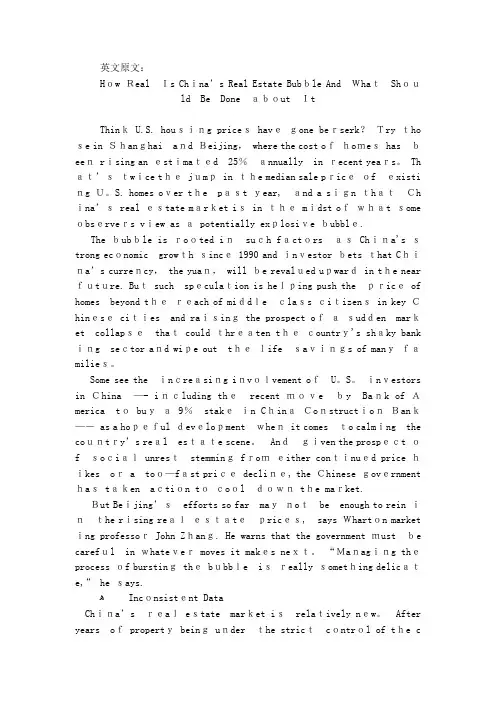
英文原文:How Real Is China’s Real Estate Bubble And WhatShould Be Done about ItThink U.S. housing prices havegone berserk?Try tho se in Shanghai and Beijing, where the cost ofhomes has been rising an estimated 25%annually in recent years。
Th at’stwice the jump in the median sale priceof existi ng U。
S. homes over the past year, and a sign thatCh ina’s real estate market is in the midst ofwhat some observers view as a potentially explosive bubble.The bubble is rooted insuch factors as China's strong economic growth since 1990 and investor bets that China’s currency, the yuan, will be revalued upward in the near future. But such speculation is helping push the price of homes beyond thereach of middle class citizens in key Chinese cities and raising the prospect ofasudden market collapsethat could threaten thecountry's shaky bank ing sector and wipe out thelife savings of manyfamilies。
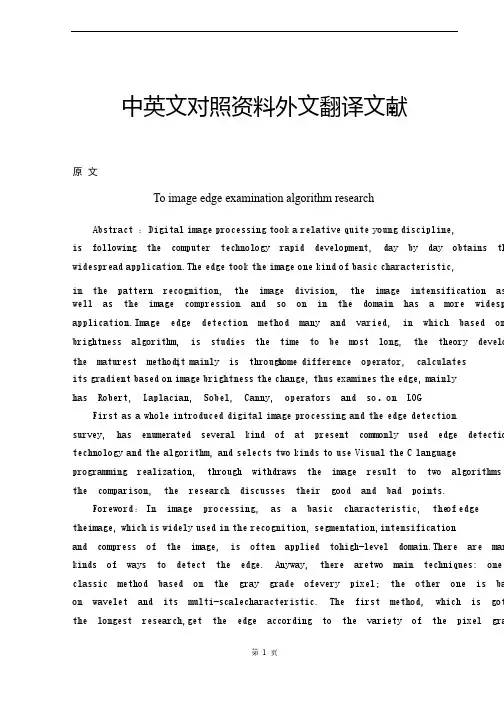
第 1 页中英文对照资料外文翻译文献原 文To image edge examination algorithm researchAbstract :Digital image processing took a relative quite young discipline,is following the computer technology rapid development, day by day obtains th widespread application.The edge took the image one kind of basic characteristic,in the pattern recognition, the image division, the image intensification as well as the image compression and so on in the domain has a more widesp application.Image edge detection method many and varied, in which based on brightness algorithm, is studies the time to be most long, the theory develo the maturest method, it mainly is through some difference operator, calculates its gradient based on image brightness the change, thus examines the edge, mainlyhas Robert, Laplacian, Sobel, Canny, operators and so on LOG 。
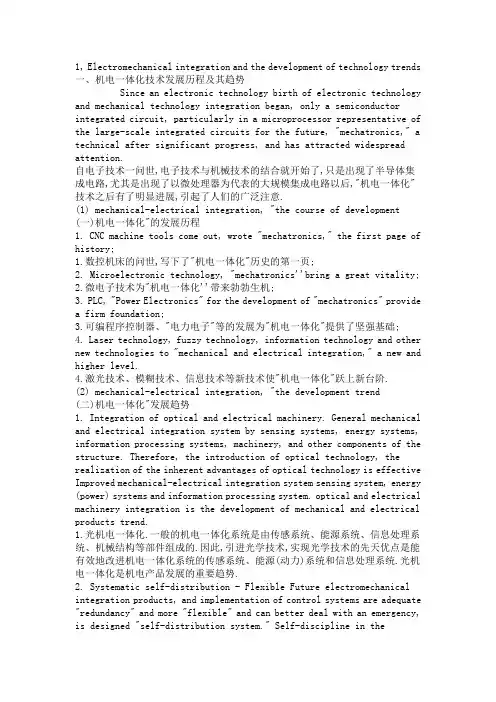
1, Electromechanical integration and the development of technology trends 一、机电一体化技术发展历程及其趋势Since an electronic technology birth of electronic technology and mechanical technology integration began, only a semiconductor integrated circuit, particularly in a microprocessor representative of thelarge-scale integrated circuits for the future, "mechatronics," a technical after significant progress, and has attracted widespread attention.自电子技术一问世,电子技术与机械技术的结合就开始了,只是出现了半导体集成电路,尤其是出现了以微处理器为代表的大规模集成电路以后,"机电一体化"技术之后有了明显进展,引起了人们的广泛注意.(1) mechanical-electrical integration, "the course of development(一)机电一体化"的发展历程1. CNC machine tools come out, wrote "mechatronics," the first page of history;1.数控机床的问世,写下了"机电一体化"历史的第一页;2. Microelectronic technology, "mechatronics''bring a great vitality;2.微电子技术为"机电一体化''带来勃勃生机;3. PLC, "Power Electronics" for the development of "mechatronics" providea firm foundation;3.可编程序控制器、"电力电子"等的发展为"机电一体化"提供了坚强基础;4. Laser technology, fuzzy technology, information technology and other new technologies to "mechanical and electrical integration," a new and higher level.4.激光技术、模糊技术、信息技术等新技术使"机电一体化"跃上新台阶.(2) mechanical-electrical integration, "the development trend(二)机电一体化"发展趋势1. Integration of optical and electrical machinery. General mechanical and electrical integration system by sensing systems, energy systems, information processing systems, machinery, and other components of the structure. Therefore, the introduction of optical technology, the realization of the inherent advantages of optical technology is effective Improved mechanical-electrical integration system sensing system, energy (power) systems and information processing system. optical and electrical machinery integration is the development of mechanical and electrical products trend.1.光机电一体化.一般的机电一体化系统是由传感系统、能源系统、信息处理系统、机械结构等部件组成的.因此,引进光学技术,实现光学技术的先天优点是能有效地改进机电一体化系统的传感系统、能源(动力)系统和信息处理系统.光机电一体化是机电产品发展的重要趋势.2. Systematic self-distribution - Flexible Future electromechanical integration products, and implementation of control systems are adequate "redundancy" and more "flexible" and can better deal with an emergency, is designed "self-distribution system." Self-discipline in thedistribution system, the various subsystems are independent of each other's work, the subsystem for system services, and has its own "self-discipline", according to different environmental conditions react differently. Its characteristics are subsystem can generate its own information and additional information given in the overall premise, specific "action" can be changed. In this way, significantly increase the system's ability to adapt (flexible), not because of the failure of a subsystem of the whole system.2.自律分配系统化——柔性化.未来的机电一体化产品,控制和执行系统有足够的“冗余度”,有较强的“柔性”,能较好地应付突发事件,被设计成“自律分配系统”。
英语专业毕业论文题目(中英
文对照版)
撰写人:XXX 本文档介绍了XXXXX.
YOUR
LOG
英语专业毕业论文题目(中英文对照版)本文关键词:英语,中英文对照,题目,专业毕业论文
英语专业毕业论文题目(中英文对照版)本文简介:对于一篇英文论文来说,题目是留给导师和读者的第一印象,题目拟的不好,很难引起读者的兴趣和共鸣,也难以彰显作者的学术水平,本文选取了60篇优秀的英语专业毕业论文题目,这60个题目都是中英文对照版,供英文专业的毕业生参考。
1、国际商务谈判中的双赢语用策略TheWin-
英语专业毕业论文题目(中英文对照版)本文内容:对于一篇英文论文来说,题目是留给导师和读者的第一印象,题目拟的不好,很难引起读者的兴趣和共鸣,也难以彰显作者的学术水平,本文选取了60篇优秀的英语专业毕业论文题目,这60个题目都是中英文对照版,供英文专业的毕业生参考。
1、国际商务谈判中的双赢语用策略
The Win-Win Pragmatic Strategies in International Business Negotiation
2、Grice 的合作原则在国际商务谈判中的应用
The Application of Grice’s Cooperation Principle in International Business Negotiation。
英文论文APA格式英文论文一些格式要求与国内期刊有所不同。
从学术的角度讲,它更加严谨和科学,并且方便电子系统检索和存档。
版面格式表格表格的题目格式与正文相同,靠左边,位于表格的上部。
题目前加Table后跟数字,表示此文的第几个表格。
表格主体居中,边框粗细采用0.5磅;表格内文字采用Times New Roman,10磅。
举例:Table 1. The capitals,assets and revenue in listed banks图表和图片图表和图片的题目格式与正文相同,位于图表和图片的下部.题目前加Figure 后跟数字,表示此文的第几个图表。
图表及题目都居中。
只允许使用黑白图片和表格.举例:Figure 1。
The Trend of Economic Development注:Figure与Table都不要缩写。
引用格式与参考文献1. 在论文中的引用采取插入作者、年份和页数方式,如"Doe (2001, p。
10)reported that …" or "This在论文中的引用采取作者和年份插入方式,如”Doe (2001,p.10)reported that …” or ”This problem has been studied previously (Smith, 1958, pp.20-25)。
文中插入的引用应该与文末参考文献相对应。
举例:Frankly speaking, it is just a simulating one made by the government, or a fake competition,directly speaking。
(Gao, 2003,p.220)。
2。
在文末参考文献中,姓前名后,姓与名之间以逗号分隔;如有两个作者,以and连接;如有三个或三个以上作者,前面的作者以逗号分隔,最后一个作者以and连接。
3。
参考文献中各项目以“点"分隔,最后以“点"结束。
英语原文Intelligent Traffic Light Controlby Marco Wiering The topic I picked for our community project was traffic lights. In a community, people need stop signs and traffic lights to slow down drivers from going too fast. If there were no traffic lights or stop signs, people’s lives would be in danger from drivers going too fast.The urban traffic trends towards the saturation, the rate of increase of the road of big city far lags behind rate of increase of the car.The urban passenger traffic has already become the main part of city traffic day by day and it has used about 80% of the area of road of center district. With the increase of population and industry activity, people's traffic is more and more frequent, which is unavoidable. What means of transportation people adopt produces pressure completely different to city traffic. According to calculating, if it is 1 to adopt the area of road that the public transport needs, bike needs 5-7, car needs 15-25, even to walk is 3 times more than to take public transits. So only by building road can't solve the city traffic problem finally yet. Every large city of the world increases the traffic policy to the first place of the question.For example,according to calculating, when the automobile owning amount of Shanghai reaches 800,000 (outside cars count separately ), if it distributes still as now for example: center district accounts for great proportion, even when several loop-lines and arterial highways have been built up , the traffic cannot be improved more than before and the situation might be even worse. So the traffic policy Shanghai must adopt , or called traffic strategy is that have priority to develop public passenger traffic of city, narrow the scope of using of the bicycle progressively , control the scale of growth of the car traffic in the center district, limit the development of the motorcycle strictly.There are more municipals project under construction in big city. the influence on the traffic is greater.Municipal infrastructure construction is originally a good thing of alleviating the traffic, but in the course of constructing, it unavoidably influence the local traffic. Some road sections are blocked, some change into an one-way lane, thus the vehicle can only take a devious route . The construction makes the road very narrow, forming the bottleneck, which seriously influence the car flow.When having stop signs and traffic lights, people have a tendency to drive slower andlook out for people walking in the middle of streets. To put a traffic light or a stop sign in a community, it takes a lot of work and planning from the community and the city to put one in. It is not cheap to do it either. The community first needs to take a petition around to everyone in the community and have them sign so they can take it to the board when the next city council meeting is. A couple residents will present it to the board, and they will decide weather or not to put it in or not. If not put in a lot of residents might be mad and bad things could happened to that part of the city.When the planning of putting traffic lights and stop signs, you should look at the subdivision plan and figure out where all the buildings and schools are for the protection of students walking and riding home from school. In our plan that we have made, we will need traffic lights next to the school, so people will look out for the students going home. We will need a stop sign next to the park incase kids run out in the street. This will help the protection of the kids having fun. Will need a traffic light separating the mall and the store. This will be the busiest part of the town with people going to the mall and the store. And finally there will need to be a stop sign at the end of the streets so people don’t drive too fast and get in a big accident. If this is down everyone will be safe driving, walking, or riding their bikes.In putting in a traffic light, it takes a lot of planning and money to complete it. A traffic light cost around $40,000 to $125,000 and sometimes more depending on the location. If a business goes in and a traffic light needs to go in, the business or businesses will have to pay some money to pay for it to make sure everyone is safe going from and to that business. Also if there is too many accidents in one particular place in a city, a traffic light will go in to safe people from getting a severe accident and ending their life and maybe someone else’s.The reason I picked this part of our community development report was that traffic is a very important part of a city. If not for traffic lights and stop signs, people’s lives would be in danger every time they walked out their doors. People will be driving extremely fast and people will be hit just trying to have fun with their friends. So having traffic lights and stop signs this will prevent all this from happening.Traffic in a city is very much affected by traffic light controllers. When waiting for a traffic light, the driver looses time and the car uses fuel. Hence, reducing waiting times before traffic lights can save our European society billions of Euros annually. To make traffic light controllers more intelligent, we exploit the emergence of novel technologies such as communication networks and sensor networks, as well as the use of more sophisticated algorithms for setting traffic lights. Intelligent traffic light control does not only mean thattraffic lights are set in order to minimize waiting times of road users, but also that road users receive information about how to drive through a city in order to minimize their waiting times. This means that we are coping with a complex multi-agent system, where communication and coordination play essential roles. Our research has led to a novel system in which traffic light controllers and the behaviour of car drivers are optimized using machine-learning methods.Our idea of setting a traffic light is as follows. Suppose there are a number of cars with their destination address standing before a crossing. All cars communicate to the traffic light their specific place in the queue and their destination address. Now the traffic light has to decide which option (ie, which lanes are to be put on green) is optimal to minimize the long-term average waiting time until all cars have arrived at their destination address. The learning traffic light controllers solve this problem by estimating how long it would take for a car to arrive at its destination address (for which the car may need to pass many different traffic lights) when currently the light would be put on green, and how long it would take if the light would be put on red. The difference between the waiting time for red and the waiting time for green is the gain for the car. Now the traffic light controllers set the lights in such a way to maximize the average gain of all cars standing before the crossing. To estimate the waiting times, we use 'reinforcement learning' which keeps track of the waiting times of individual cars and uses a smart way to compute the long term average waiting times using dynamic programming algorithms. One nice feature is that the system is very fair; it never lets one car wait for a very long time, since then its gain of setting its own light to green becomes very large, and the optimal decision of the traffic light will set his light to green. Furthermore, since we estimate waiting times before traffic lights until the destination of the road user has been reached, the road user can use this information to choose to which next traffic light to go, thereby improving its driving behaviour through a city. Note that we solve the traffic light control problem by using a distributed multi-agent system, where cooperation and coordination are done by communication, learning, and voting mechanisms. To allow for green waves during extremely busy situations, we combine our algorithm with a special bucket algorithm which propagates gains from one traffic light to the next one, inducing stronger voting on the next traffic controller option.We have implemented the 'Green Light District', a traffic simulator in Java in which infrastructures can be edited easily by using the mouse, and different levels of road usage can be simulated. A large number of fixed and learning traffic light controllers have already been tested in the simulator and the resulting average waiting times of cars have been plotted and compared. The results indicate that the learning controllers can reduce average waiting timeswith at least 10% in semi-busy traffic situations, and even much more when high congestion of the traffic occurs.We are currently studying the behaviour of the learning traffic light controllers on many different infrastructures in our simulator. We are also planning to cooperate with other institutes and companies in the Netherlands to apply our system to real world traffic situations. For this, modern technologies such as communicating networks can be brought to use on a very large scale, making the necessary communication between road users and traffic lights possible.中文翻译:智能交通信号灯控制马克·威宁我所选择的社区项目主题是交通灯。
DamThe first dam for which there are reliable records was build or the Nile River sometime before 4000 . It was used to divert the Nile and provide a site for the ancient city of Memphis .The oldest dam still in use is the Almanza Dam in Spain, which was constructed in the sixteenth century. With the passage of time,materials and methods of construction have improved. Making possible the erection of such large dams as the Nurek Dam, which is being constructed in the . on the vaksh River near the border of Afghanistan. This dam will be 1017ft(333m) high, of earth and rock fill. The failure of a dam may cause serious loss of life and property; consequently, the design and maintenance of dams are commonly under government surveillance. In the United States over 30,000 dams are under the control of state authorities. The 1972 Federal Dams Safety Act (PL92-367)requires periodic inspections of dams by qualified experts. The failure of the Teton Dam in Idaho in June 1976 added to the concern for dam safety in the United States.1 Type of DamsDams are classified on the type and materials of construction, as gravity, arch, buttress ,and earth .The first three types are usually constructed of concrete. A gravity dam depends on its own weight for stability and it usually straight in plan although sometimes slightly curved.Arch dams transmit most of the horizontal thrust of the water behind them to the abutments by arch action and have thinner cross sections than comparable gravity dams. Arch dams can be used only in narrow canyons where the walls are capable of withstanding the thrust produced by the arch action. The simplest of the many types of buttress dams is the slab type, which consists of sloping flat slabs supported at intervals by buttresses. Earth dams are embankments of rock or earth with provision for controlling seepage by means of dam may be included in a single structure. Curved dams may combine both gravity and arch action to achieve stability. Long dams often have a concrete river section containing spillway and sluice gates and earth or rock-fill wing dams for the remainder of their length.The selection of the best type of dam for a given site is a problem in both engineering feasibility and cost. Feasibility is governed by topography, geology and climate. For example, because concrete spalls when subjected to alternate freezing and thawing, arch and buttress dams with thin concrete section are sometimes avoided in areas subject to extreme cold. The relative cost of the various types of dams depends mainly on the availability of construction materials near the site and the accessibility of transportation facilities. Dams are sometimes built in stages with the second or late stages constructed a decade or longer after the first stage.The height of a dam is defined as the difference in elevation between the roadway, or spillway crest, and the lowest part of the excavated foundation. However, figures quoted for heights of dams are often determined in other ways. Frequently the height is taken as the net height is taken as the net height above the old riverbed.on damsA dam must be relatively impervious to water and capable of resisting the forces acting on it. The most important of these forces are gravity (weight of dam) , hydrostatic pressure, uplift, ice pressure, and earthquake forces are transmitted to the foundation and abutments of the dam, which react against the dam with an equal and opposite force, the foundation reaction. The effect of hydrostatic forces caused by water flowing over the dam may require consideration in special cases.The weight of a dam is the product of its volume and the specific weight of the material. The line of action of dynamic force passes through the center of mass of the cross section. Hydrostatic force may act on both the upstream and downstream faces of the dam. The horizontal componentH of the hydrostatic force is the force or unit width of damhit is2/2HrhhWhere r is the specific weight of water and h is the depth of water .The line of action of this force is h/3 above the base of thedam .The vertical component of the hydrostatic force is equal to the weigh of water vertically above the face of the dam and passes through the center of gravity of this volume of water.Water under pressure inevitably finds its way between the dam And its foundation and creates uplift pressures. The magnitude of the uplift force depends on the character of the foundation and the construction methods. It is often assumed that the uplift pressure varies linearly from full hydrostatic pressure at the upstream face (heel)to full tail-water pressure at the downstream face (toe).For this assumption the uplift force U isU=r(h1+h2)t/2Where t is the base thickness of the dam and h1and h2 are the water depths at the heel and toe of the dam,respectively. The uplift force will act through the center of area of the pressure trapezoid.Actual measurements on dams indicate that the uplift force is much less than that given by Eq.(2)Various assumption have been made regarding the distribution of uplift of Reclamation sometimes assumes that the uplift pressure on gravity dams varies linearly from two-thirds of full uplift at the heel to zero at the toe. Drains are usually provided near the heel of the dam to permit the escape of seepage water and relieve uplift.译文:坝据可靠记载,世界上第一座坝是公元前4000年以前在尼罗河上修建的。
薪酬管理毕业论文外文翻译资料篇一:薪酬管理体系中英文对照外文翻译文献中英文对照外文翻译(文档含英文原文和中文翻译)Enterprises salary system design andperformance evaluationAbstractAny effective way of management must rely on a basis: people, all the staff of enterprises. Compensation system as an important aspect of enterprise management system, for an enterprise to attract, retain and motivate employees have a significant impact, attract, retain and motivate key talent, has become the core of the enterprise recognized goal. The compensation system design is not only an effective way to realize the core objective, is also an important content of modern enterprise development.Key words: salary system and equity incentive, senior executives, design1 IntroductionHuman capital to the enterprise wealth maximization, the greatest degree of retaining key talent, attract potential talent, the basic principals and successful is perfect competitive compensation system. With the concept of human capital is more and more people Heart, attract, retain and motivate key talent, has become the core of enterprise determine target, compensation system for enterprises An important aspect of the system, to attract talents play an important role. Compensation system design is an effective way to reality is the core objective, but also an important content of the development of the enterprise to modernization, so the height weight by enterprises Depending on the.2 Literature reviewEarly in the traditional compensation phase, the employers always minimize workers to cut costs as much as possible, and through this method make the Labor of workers have to work harder in order to get paid enough to make a living. William. First, Quesnay’s minimum wage theory is that wages and other commodities, there is a natural value, namely maintain staff minimum standard of living life information value,the minimum wage for workers does not depend on the enterprise or the employer s subjective desire, but the result of the competition in the market. The classical economists Muller believed that certain conditions, the total capital in the enterprise salary depends on the labor force and for the purchase of labor relationship between capital and other capital; For the payment of capital wage fund is difficult to change in the short term. Wages fund quantity depends on two factors: one is a worker, directly or indirectly, in the production of products and services production efficiency; the other one is in the process of production of these goods directly or indirectly employ labor quantity. With the development of era, the simple forms of employment have already can t satisfy the demand of the workers, so some interests to share views was put forward to motivate workers. On this basis, the Gantt invented the complete tasks rewarded system to perfect the incentive measures. Represented by Americaneconomist Becker’s theory of human capital school of thought argues that human capital is determined by the human capital investment, is present in the human body to the content of knowledge, skills, etc. Martin Weizmann share of economic theory that wages should be linked to corporate profits. Increase in profits, employee wages fund, increased profits, and employee wages fund. Between enterprises and employees is the key of the labor contract is not in a fixed wage of how many, but in the division of labor both sides share proportion. In modern compensation phase, thecontents of the compensation has been changed, increased a lot of different compensation models, and more and more pay attention to employee s personal feelings and development, employees can even according to individual condition choose different salary portfolio model. Employees can be paid off on surface of the material and spiritual.3 Pay system overviewIn the past the traditional pay system, usually are business owners value orientation as the guide to carry on the design. With the continuous development of the overall market environment, in the modern enterprise management concept has also changed. They are aware of the established compensation system should adapt to the employee benefit as a starting point, the self-interest pursuit and employee demand together, to establish a set of enterprises and employees to maximize the interests of the two-way, so as to achieve win-win situation. Since the 90 s, the westerndeveloped economies in the enterprise owners and managers try to change the traditional form of compensation, relocation compensation system, the importance of also constantly try to innovate salary system of design and diversification.Performance pay system is established in accordance with the enterprise organization structure based on the results of the individual or team performance appraisal for salary distribution system. Total compensation is generally associated with individual or team performance. Now the enterprise model is used to combine individual performance and team performance. At the same time will be long term incentive and short-term incentive flexible model. In this kind of pay structure, contains a variety of forms of performance pay.Skill-based pay system on the basis of employees skill determine employee wages level, and to the improvement of skills as their employeesprogress criteria. The compensation model can encourage employees to continuously learn new knowledge, to keep up with The Times, is the industry leader, when technology and equipment upgrades to the fastest response time to complete the change, and is helpful to form the learning corporate culture. If for flat organization structure, management jobs and opportunities for advancement are less, the compensation system can be very skillful professionals to make up for in terms of compensation. But with technical compensation system with the篇二:薪酬外文文献毕业论文材料:英文文献及译文课题名称:薪酬体系专业工商管理学生姓名班级 B 工商 072学号指导教师专业系主任完成日期二零一一年三月The Changing Pattern of Pay and BenefitsTudor, Thomas R, Trumble, Robert RJournal of Compensation Benefits/May/2008Today, many companies still base their reward systems on the 1950s compensation model made popular during the brief period when U.S. companies dominated the world. With todays increasingly competitive environment, however, companies must look more closely at thecost-benefit of rewards, instead of just using them in an attempt to reduce employee dissatisfaction. Companies must provide short-term motivation and encourage employees to develop long-term skills that will aid the company. Most importantly, companies must also attract and retain highperformers, instead of alienating them with pay systems that give everyone pay increases without regard to levels of performance. For example, such new compensation approaches may include skill-based pay, gainsharing plans, and flexible benefits systems.Traditional compensation approaches are still often modeled on the centralization-based organizational model, in which decisions were made at the top and management rigidly defined tasks. However, with global competition becoming an increasingly prominent issue, companies need reward systems that match their movement to decentralized structures. Larger numbers of companies are also becoming very aware that they cannot just pass additional compensation costs onto future customers. Today, our pay systems must move in step with the participative-management trend by becoming more flexible instead of remaining fixed. This adjustment involves many factors including shorter product life cycles, a need to be more flexible, a need for workers to continually gain additional skills, and for them to think more on the job.In today s most successful companies, employee rewards and benefits are increasingly incorporated into an organization s strategic planning. Why? The rationale is that employee compensation has a substantial impact on the long-term financial position of a firm. Compensation structures should consider an organization s strategic requirements and should match organizational goals. Compensation strategic planning shouldinvolve:consideration of the internal and external environment; and creation of an organization s compensation statement, compensation goals, and the development of compensation policies.Today, one strategic compensation trend is the use of pay incentives instead of the traditional, annual “everybody gets” pay increase. The rationale is to control costs and to more closely tie performance to compensation. We can group the changing pattern of compensation into twogeneral areas: Pay Method Trends and Benefits Trends. Human Resources managers should familiarize themselves with these changing trends and determine the plan that is most suitable for their organization.PAY METHOD TRENDSThere are a number of pay methods available for use by employers, including general pay increases, cost-of-living increases, merit pay, bonuses, skill-based pay, competence-based pay, CEO compensation, gainsharing, and various types of incentive pay.General Pay IncreaseA general pay increase is a pay increase given to everyone in a company. It can be a lump-sum payment, but it is more likely to be a percentage increase in base salary. The employer s rationale for the pay increase may have been the result of a market survey, job evaluation, or just a profitable year. The trend, however, is for general increases to decline as pay-for-performance systems become increasingly dominant. In addition, giving everyone the same raise sometimes decreases morale becausehigh-performing employees see poor performers getting the same reward. Cost-of-Living IncreaseCost-of-living increases are general pay increases triggered by a rise in an inflation-sensitive index, such as the consumer price index or the producer price index. As with general pay increases, the use ofcost-of-living pay increases is decreasing among companies. The rationale for this decrease is that with lower inflation (thus little change in prices), incomes are more stable and the need for inflation adjustments is not as great as it was in the past. In addition, collective bargaining agreements are now less likely to include provisions for cost-of-living increases, so nonunion firms are not under as much pressure to provide them in an attempt to match union-negotiated compensation. Their declinecan also be attributed to the fact that employers are moving away from pay systems that are nonperformance related.Merit PayMerit pay is another generic term in which pay incentives are given for overall job performance.2 Some problems frequently encountered with merit pay plans include:? the use of subjective criteria when measuring employee performance; ? a lack of uniform standards for rating individual employees;? differences among managers in how to make individual ratings.Merit pay was the first attempt by firms to create apay-for-performance system. However, due to employer (and employee) dissatisfaction with merit pay plans, the trend is to eliminate them and instead use pay-for-performance plans that are more objective (such as bonus plans), and that use specific performance measuring criteria that aid in the performance appraisal process.3 This trend includes both the private and public sectors, because the merit pay system in the federal sector has also been inadequate.BonusA bonus is a generic term involving a type of pay-for-performance plan. Managers can give a bonus for individual or group performance, and for meeting objectives such as MBO (management by objectives). Researchers and practitioners have given these plans high marks for motivating employees, for creating loyalty, and for meeting performance objectives. In addition, bonuses reduce the turnover of high-performing employees and increase the turnover of low performers, who do not get bonuses. If the bonus system is well-designed, they also create internal equity. As such, bonus systems (pay-for-performance) are the current trend in compensation.Skill-Based PaySkill-based pay emphasizes a company s desire to increase the skills and knowledge of its workforce. It may involve classes, voluntary job rotation, or tests. Itsbenefits are many, including having trained people available to do a job if someone is absent. Skill-based pay also works well with quality circles because:? it provides employees with a better understanding of the jobs their coworkers perform;? it reduces resistance to restructuring or other needed changes; ? it leads to a more flexibleworkforce that can better adapt to new technologies or processes; and it encourages a learning environment.It does, however, require a large investment in training which can be expensive.Competence-Based PayCompetence-based pay (the grid system) is very new and does vary from plan-to-plan. The idea is not only to reward employees for how well they do a job, but for how they do the job. For example, a competence-based pay plan can be used to persuade workers to use the computers that are sitting on their desks, or to adapt to other changes that come along. The rationale behind a competence-based pay plan is to keep employee skills current.CEO CompensationThe compensation of CEOs (and other top executives) has also been changing, and now includes more pay incentives—such as stock options —to better link performance with compensation. Plans linking executive pay with performance may include stock options, cash bonuses, phantom stock, or deferred compensation, all of which are ways of making top management more accountable for company performance. Today, performance considerations are a larger part of executive compensation. TheSecurities and Exchange Commission also requires corporations to explain the rationale behind their executive compensation programs to shareholders.GainsharingGainsharing is a pay-for-performance plan in which “gains” are shared with employees for improvements in profitability orproductivity.Gainsharing plans are designed to create a partnership with employees so that both management and labor are working toward the same goals and that both groups are benefiting from the results. Gainsharing is a growing trend, and it fits well with other trends, such as participatory management, worker empowerment, and teamwork. It is also being used in many service businesses, such as banking and insurance. Gainsharing encourages employee involvement and acceptance of change, and aligns employee goals with company goals.Five Types of Pay IncentivesWhile all pay incentives can be generically coined as “gainsharing,”we will briefly mention five types:1. ESOPs. Employee Stock Ownership Plans allow the sharing of gains throughdividends and any increase in the value of company stock. ESOPs do create ownership in the company for employees that may result in additional motivation, but they do not necessarily have aparticipative-management component.2. Profit-Sharing Plans. Profit-sharing plans allow employees to share in the revenue they helped generate. This sharing can be either deferred or immediate. Some observers argue that associating rewards and performance is difficult if managersonly give rewards annually, and that perhaps employees should not share in the profits because they do not share in the risks. However, companiessuch as Lincoln Electric and Ford feel that profit sharing is a strong inducement to increase performance. The current rate of growth of these plans is significant. For best motivational results, companies should use a system that is based on some criteria that employees understand, instead of just an arbitrary amount. The advantage of profitsharing plans is that employers do not have to pay a large sum of money if the profit target is not met.3. Scanlon Plans. Scanlon plans allow employees to share in any savings in laborcost (using a ratio) that is due to their increased performance. The rationale for ScanIon plans is to help employees identify with and participate in the company. Employees participating in such plans may have access to suggestion programs, brainstorming sessions, or committees to solve production problems. The employer and the employees then share in the savings that result.4. Rucker Plans. Rucker plans allow employees to share in any improvement in theratio of employee costs to the valued added in manufacturing. This is the most complex gainsharing plan, because it deals with four variables: labor costs, sales value of production (changes in equipment, or work methods, for example), purchases of outside services such as subcontracting, or utilities, and purchases of outside materials, involving “inventory, theft, and so on”. Rucker plans are designed to give employees a stake in areas such as reducing labor costs, using raw materials, and outsourcing decisions. As such, everyone shares in the savings.5. Improshare Plans. Improshare plans allow employees to share in productivitygains that occur because of their efforts.[sup5] Following the Improshare approach, managers give bonuses when the actual hours for a specific amount of productivity are less than the standard that they created using a formula. The savings are split between the company and the workers, in a ratio such as 50?50. CHANGES IN BENEFIT PLANSChanges in benefit plans have occurred as a result of efforts to keep up with trends, to contain costs, and to meet government regulations. Employees often view benefits as an entitlement, and their cost—which has steadily increased—now averages 36 percent of total wages. The trend is to get the most out of benefits, while keeping costs down. For example, employers do not want to pay for any overlap of coverage, or to pay too much for coverage. As their costs continue to go up, employers are now starting to question how much employees value their benefits. For example: ? Do they support recruitment, motivate, and retain good employees? ? Do they support the strategic mission of the firm?? Do proposed benefits support the company s retention goals and the demographics of potential recruits?? Do they support the company culture or the culture the company now wants to promote? A movement now exists among employers for measuring benefit results and continuously evaluating benefits. A focus on Total Quality Management makes the internal employee the customer of HR departments who have the product of “benefits.” HR departments want to satisfy the篇三:企业薪酬管理外文翻译文献企业薪酬管理外文翻译文献(文档含英文原文和中文翻译)翻译:宽带薪酬体系——薪酬模式的创新视野摘要:最近,有关“企业人力资源管理中的有效激励”的问题吸引了许多产业界和学术界的学者的关注。
What is a scientific paper? A paper is an organized description of hypotheses, data and conclusions, intended to instruct the reader. Papers are a central part of research. If your research does not generate papers, it might just as well not have been don e. “Interesting and unpublished” is equivalent to “non-existent.”什么是科技论文?科技论文是集假说、数据和结论为一体的概括性描述,以此向读者论述。
论文是研究工作的中心部分。
如果你的研究没有写成论文,也就等同于没有做研究。
有意义但没有发表,等同于不存在。
Realize that your objective in research is to formulate and test hypotheses, to draw conclusions from these tests, and to teach these conclusions to others. Your objective is not to “collect data.”要意识到研究的目的是为了形成并证实假说,从一些测试中得出结论,并把结论传授给别人。
你的研究目的不是简单的收集数据。
A paper is not just an archival device for storing a completed research program, it is also a structure for planning your research in progress. If you clearly understand the purpose and form of a paper, it can be immensely useful to you in organizing and conducting your research. A good outline for the paper is also a good plan for the research program. You should write and rewrite these plans/outlines throughout the course of the research. At the beginning, you will have mostly plan; at the end, mostly outline. The continuous effort to understand, analyze, summarize, and reformulate hypotheses on paper will be immensely more efficient for you than a process in which you collect data and only start to organize them when their collection is“complete.”一篇论文并不仅仅是收集已经得到的研究结果,它也有助于形成进一步的研究工作的框架。
如果明确了论文的目的,这对于计划开展你的研究工作有很大益处。
好的文章提要也是研究工作的好计划,在研究的过程中,应该反复修改这些计划或提要。
研究工作开始时,应有完善的计划;工作结束时,应充分的总结。
最有效率的做法是及时的理解,分析,总结,形成假说;而不是等到完成时才开始收集和整理数据。
01 The reason for outlines. First emphasize the central place of an outline in writing papers, preparing seminars, and planning research. I especially believe that for you, and for me, it is most efficient to write papers from outlines. An outline is a written plan of the organization of a paper, including the data onwhich it rests. You should, in fact, think of an outline as a carefully organized and presented set o data,with attendant objectives, hypotheses and conclusions, rather than an outline of text.为什么要写提纲?我在这里要强调提纲在论文写作,准备报告以及研究计划中的重要作用。
我尤其相信按照提纲进行写作对我们大家都是最有效的方法。
提纲是一篇论文的行文计划,应该包括论文所依靠的数据。
事实上,提纲不仅仅是列出各段的内容,而是按照目的,假说,结论来精心组织数据。
An outline itself contains little text. If you and I can agree on the details of the outline (that is, on the data and organization), the supporting text can be assembled fairly easily. If we do not agree on the outline, any text is useless. Much of the time in writing a paper goes into the text; most of the thought goes into the organization of the data and into the analysis. It can be relatively efficient to go through several (even many) cycles of an outline before beginning to write text; writing many versions of the full text of a paperis slow.提纲本身应该文字简练。
如果大家都同意提纲中的细节部分,那么正文组织起来就更容易。
在我们就提纲达成一致以前,写正文是没有意义的。
写文章时,大部份时间花在写正文上;而大部份思考是用在整理和分析数据。
在动笔前,详细讨论几遍写作提纲会提高写作效率;写很多遍正文反倒很慢。
All the writing that I do - papers, reports, proposals (and, of course, slides for seminars)- I do fromoutlines. I urge you to learn how to use them as well.我写的所有文章,包括论文,报告,建议(当然还有讨论会的胶片)都从提纲开始。
我也希望你们能学会使用它。
How should you construct an outline? The classical approach is to start with a blank piece of paper, and write down, in any order, all important ideas that occur to you concerning the paper. Ask yourself the obvious questions:“Why did I do this work?” “What does it mean?”“What hypothesis did I mean to test?”“What ones did I actually test?”“What were the results?”“Did the work yield a new method or compound? What?”“What measurements did I make?”“What compounds? How were they characterized?” Sketch possible equations, figures, and schemes. It is essential to try to get the major ideas written down. If you start the research to test one hypothesis, and decide, when you see what you have, that the data really seem to test some other hypothesis better, don't worry. Write them both down, and pick the best combinations of hypotheses, objectives and data. Often the objectives of a paper when it is finished are different from those used to justify starting the work. Much of good science is opportunistic andrevisionist.你应该如何起草你的提要?最经典的方法就是找一页空白的纸,以任何顺序,写下与这篇文章有关的所有重要观点。
自问一些显而易见的问题:为什么我要做这项工作?它意味着什么? 我要验证哪些假设? 我究竟验证了哪些假设?结果如何?这项工作产生了新方法或新物质吗?都是什么?我都做了那些测试?什么化合物?它们是如何表征的?展示相关的方程,图表和示意图。
试着写出主要的观点。
如果你的研究开始是为证实一个假设,然而当你发现你有的数据仿佛真的可以更好地验证其它的假设时,你也不必担心。